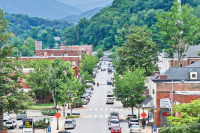Remarkable red cedar
I sometimes have occasion to drive Interstate 81 up the Great Valley of Tennessee and Virginia to Washington, D.C. As soon as I pass out of Western North Carolina into the terrain north of Knoxville, the dominant tree along the roadside becomes red cedar. Spread throughout abandoned fields and clinging to the narrow ledges of rock outcrops, they flicker like green torches for hundreds of miles. I can never get enough of limestone country or the stands of red cedar that flourish there. And I never cease to wonder at the variety of shapes the tree can display within a short distance.
We have red cedar here in Western North Carolina, of course, but not in the numbers found in the Great Valley. When out poking around in second-growth habitats where it is found here, I have to remind myself that the tree is not really a cedar (Thuja) but a juniper (Juniperus). True cedars like northern white cedar have flat branchlets. True junipers have rounded branchlets. Red cedar (Juniperus virginiana) has the latter. It’s the only native juniper that we have in any abundance in WNC.
Red cedars display two distinct forms that have been recognized taxonomically: one shape is conical and spire-like in outline, with branches ascending at a sharp angle; the other is not spire-like, taking on a broadly conical form with widely spreading branches. There are, however, many trees that are intermediate in form.
The light reddish-brown bark of the tree peels off in fibrous strips. This reddish hue of the bark and heartwood led the early French Canadians to call the species “baton rouge,” meaning “red stick.” Finding the same tree abundant in Louisiana, they assigned the name to the site that became their state capital.
The heartwood of red cedar has long been favored for closet linings, wardrobes, and chests due to its pleasing color, aromatic odor, and moth repellant properties. For many years, it also furnished the wood for making American pencils due to its lightness and the ease with which it can be sharpened. In 1900, more than 3 million feet of quality red cedar was cut in Tennessee and floated in great timber rafts to processing centers. With prime red cedar stands practically decimated in the East, pencil manufacturers moved on to a related species in the western United States.
Because the wood is decay resistant, it has also been widely used for fence posts and exteriors. Unfortunately, the tree serves as the host for cedar apple rust, a fungus disease quite harmful to apple trees, so that it has to be eradicated around orchards.
Related Items
In winter, look for the dark blue, highly aromatic, berry-like fruiting cones that are used to flavor gin and provide food for mice and over-wintering birds. The tree spreads along fence lines where the birds perch and the rodents have runways due to their droppings, which contain seeds. The common name for cedar waxwings arose from their inordinate fondness for these berries.
In Myths of the Cherokee (1900), anthropologist James Mooney noted that, “With the Cherokee, as with nearly all other tribes east and west, the red cedar is held sacred above all other trees. The reasons for this reverence are easily found in its ever-living green, its balsamic fragrance, and the beautiful color of its fine-grained wood, unwarping and practically undecaying. The small green twigs are thrown upon the fire as incense in certain ceremonies ... as it is believed that the malevolent ghosts can not endure the smell; but the wood itself is considered too sacred to be used as fuel. In the war dance, the scalp trophies, stretched on small hoops, were hung on a cedar sapling trimmed and decorated for the occasion. According to a myth the red color comes originally from the blood of a wicked magician, whose severed head was hung at the top of a tall cedar [so that] henceforth the cedar was a ‘medicine’ tree.”
George Ellison wrote the biographical introductions for the reissues of two Appalachian classics: Horace Kephart’s Our Southern Highlanders and James Mooney’s History, Myths, and Sacred Formulas of the Cherokees. In June 2005, a selection of his Back Then columns was published by The History Press in Charleston as Mountain Passages: Natural and Cultural History of Western North Carolina and the Great Smoky Mountains. Readers can contact him at P.O. Box 1262, Bryson City, N.C., 28713, or at This email address is being protected from spambots. You need JavaScript enabled to view it..









